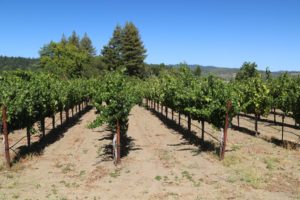
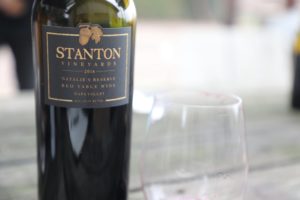
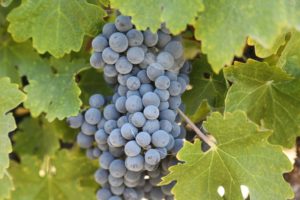 Stanton Vineyards has roots in Napa Valley dating back to 1947 when Jesse Stanton (a San Francisco native) first purchased acreage in the valley (100 acres in Yountville). He kept acquiring land and by the late 1950s owned nearly 220 acres in Napa Valley.
Stanton Vineyards has roots in Napa Valley dating back to 1947 when Jesse Stanton (a San Francisco native) first purchased acreage in the valley (100 acres in Yountville). He kept acquiring land and by the late 1950s owned nearly 220 acres in Napa Valley.
Today the Stanton’s own 75 acres of vineyards including two sites within a short distance of each other in the St. Helena Appellation: J.B. Ranch and Mills Vineyard (both east of Highway 29) and one site in Oakville bordering Highway 29 (also on its east side). They do not outsource any of the vineyard management duties, rather they have their own in-house team managing all their vineyards. And a number of their employees have been with them for years and as a result, know their vineyards extremely well.
Today they grow only red varieties including Cabernet Sauvignon, Merlot, Cabernet Franc, Petit Verdot, Malbec, Petite Sirah and Mourvèdre) and sell the grapes to local exemplary wineries such as Stag’s Leap Wine Cellars, Del Dotto, HALL, Cain and others.
Proprietor of Stanton Wines, Doug Stanton is Jesse’s grandson; Doug’s father John was born in San Francisco but raised in Los Angeles. When he retired in 1971, he was the chief chemist for the Bureau of Sanitation for the city of Los Angeles. After retiring at a fairly young age, he moved his family to Napa Valley almost immediately following his retirement to take over management of the properties his father had purchased.
After many years of growing and selling grapes (for many years their grapes were sold to what was the Napa Valley Winery Cooperative, where the present-day HALL Winery is located) Doug decided to start making wine and released his first vintage in 1999. A combination of farming top vineyards and then tasting the wines produced from their grapes by various winery clients, spurred the decision to produced wines bottled under their own label.
Their production is small, usually around 800 cases divided between two or three wines, a Cabernet Sauvignon, a Petite Sirah and a sometimes-produced red blend. Based on years of experience managing their vineyards they know where the best blocks grow within the vineyards, and they harvest only those blocks for their wine.
Their Cabernet Sauvignon is actually sourced from the same rows each year. They are only using a small percentage of their grapes for their own label; the remainder is sold to other premium producers in Napa Valley. What typically changes every year is the blending wine used and its variety. This is because every growing season is different, and it is the challenge of the winemaker to best use a blending wine which complements their Oakville Cabernet Sauvignon.
As Doug says, “producing wines has made us better farmers”.
Winemaker Dave Phinney (of Orin Swift fame) made the 2002 Stanton Vineyards vintage and crafted their wines through the 2017 vintage. Dave began his wine career at Robert Mondavi Winery as a temporary harvest intern in 1997 working several hours every day during the graveyard shift in the winery doing punch-downs and pump overs. With Mondavi’s encouragement, in 1997 Dave made a barrel of wine from second crop grapes and the next year produced his first vintage of a label he ultimately became well known for, Orin Swift. He wasn’t satisfied with the quality of the wine, so Dave sold that vintage on the bulk market (Orin Swift is now owned by E & J GALLO). Little did either Mondavi or Phinney know that eventually both would again be linked based on Phinney’s remarkable success with The Prisoner wines.
A gifted blender of both varieties and regions, Dave built his reputation on creating fruit forward (often higher alcohol), approachable blended wines that incorporated multiple varieties and regions. His winemaking has never been constrained by specific varieties or geographical places. To complement his creativity with winemaking – his wines incorporate extremely creative, unique and often eye-catching labels. And he is a master marketer – helped by the fact his wines are reasonably priced based on quality.
Select Wines
Cabernet Sauvignon
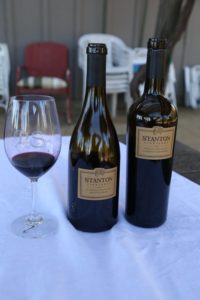
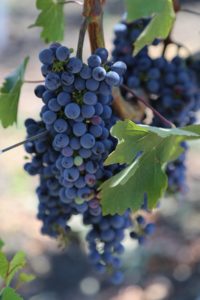 The 2021 Stanton Vineyards Cabernet Sauvignon, Oakville Napa Valley is deep ruby and opaque; their Cabernet Sauvignon never lacks for color and this vintage is no exception. Showy, opulent and voluptuous, the bouquet delivers loads of aromatic pleasure immediatley upon opening. For reference we tasted this wine three years post vintage. Ripe but perhaps not quite as much as the 2019 bottling, this wine smells like blackberry preserve, dark plum, boysenberry jam, mulberry and cherry pie. Other than a light note of cedar in the background and a bit of mocha and cocoa powder as it evolves, this wine is a forward fruited expression of the variety. We love the tug and tension of both texture and ripeness but also brightness on this vintage; its flavors include blackberry, boysenberry, dark plum and dark cherry. There is a savory and darker character that creeps in on the finish including of smoked sage, pink peppercorn, dried bay leaf and a persistent dusty character. Also minerally with a ferrous quality. The firmly gripping tannins fully coat the palate with their dusty and chalky texture. This wine is bright and energetic with lots of movement; clearly it is built to age. Nicely done.
The 2021 Stanton Vineyards Cabernet Sauvignon, Oakville Napa Valley is deep ruby and opaque; their Cabernet Sauvignon never lacks for color and this vintage is no exception. Showy, opulent and voluptuous, the bouquet delivers loads of aromatic pleasure immediatley upon opening. For reference we tasted this wine three years post vintage. Ripe but perhaps not quite as much as the 2019 bottling, this wine smells like blackberry preserve, dark plum, boysenberry jam, mulberry and cherry pie. Other than a light note of cedar in the background and a bit of mocha and cocoa powder as it evolves, this wine is a forward fruited expression of the variety. We love the tug and tension of both texture and ripeness but also brightness on this vintage; its flavors include blackberry, boysenberry, dark plum and dark cherry. There is a savory and darker character that creeps in on the finish including of smoked sage, pink peppercorn, dried bay leaf and a persistent dusty character. Also minerally with a ferrous quality. The firmly gripping tannins fully coat the palate with their dusty and chalky texture. This wine is bright and energetic with lots of movement; clearly it is built to age. Nicely done.
The 2020 Stanton Vineyards Cabernet Sauvignon, Oakville Napa Valley is medium to deep ruby; a smell good bouquet, this wine offers scents of raspberry, cherry, red plum, and blackberry. Its core of fruit is its central aromatic focus, not the oak. Superbly balanced, this wine is showing in a sweet spot five years post vintage. The palate sports flavors of red cherry, red plum, currant and raspberry. It finishes fresh, bright, tart and lively. The grainy tannins fully coat the palate and persist with the fruit on the extended finish. Vintages don’t get much more challenging than this in Napa Valley. With that said, this is one of the finer Cabernet Sauvignons we have tried from this vintage from the valley and dare we say, quite age worthy. And that is not a descriptor we generally used for 2020 Napa Valley wines. The grapes for this wine were harvested between the LNU Complex fires and the Glass Fire.
The 2019 Stanton Vineyards Cabernet Sauvignon, Oakville Napa Valley is deep ruby and opaque; open-knitted, concentrated, ripe and fully giving in terms of its aromatic immediacy, this wine is a pleasure to smell. Its scents include Satsuma plum, baked plums, cherry pie, blackberry jam, mulberry and boysenberry preserve. And other scents include dark chocolate, mocha, vanilla and sweet baking spices including cinnamon and nutmeg. If this wine was a personality, it would be hedonistic and would strongly be built with an outgoing persuasion. Smells like dessert. Across the palate, it is focused on its fruit rather than any overt barrel influences. It tastes like blackberry, boysenberry, dark cherry, Persian mulberry, dark raspberry and licorice. The ripe, resolved and lightly grainy tannins parallel the fruit in tandem on the finish with neither one pulling away from the other. Finishes with a light dusty character, felt more on the front of the palate than the back. Its alcohol is a listed 14.8% but perhaps rides a bit higher than that.
The 2017 Stanton Vineyards Cabernet Sauvignon, Oakville Napa Valley is dark ruby in color with purple tinges on the rim in the glass; the bouquet offers dark fruit including of blackberry and plum with a focus on ripe but simultaneously elegant aromatics. This is a balanced but intensely flavored bottling. It offers flavors of blackberry, dark chocolate and black currant anchored by earthy, gravelly tannins with a lingering note of dust. The finish persists brightly, while showcasing plenty of fruit. The 2017 vintage featured cool weather in spring and early summer including an abnormally rainy June. The resulting yields were low and maturity was slow and extended making for a late harvest.
Petite Sirah
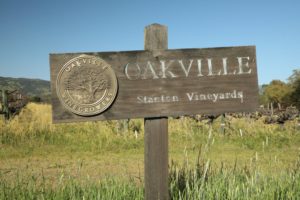
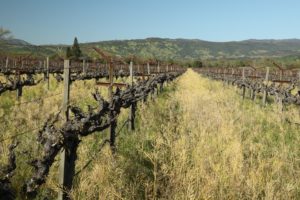
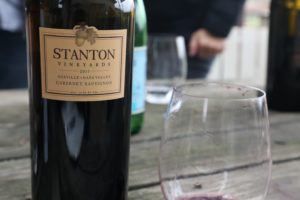 The challenge with this variety is to get it ripe each year (weather doesn’t always cooperate late in the growing season) as Petite Sirah is a fairly thin skinned grape and doesn’t have a stronger resistance to moisture, for instance as compared to the much more resilient Cabernet Sauvignon. And Stanton’s style with their Petite Sirah is to ferment it when it is very ripe; this creates a higher alcohol wine but none of the vintages we have tried over the years have been overly ripe, shown overt jammy characteristics or ‘hot’. The first Stanton Petite Sirah was bottled in 2004. The earliest Stanton Petit Sirah we tried was their 2005 vintage during our first visit with Doug in 2009; we have always been impressed with their Petite Sirah, regardless of vintage.
The challenge with this variety is to get it ripe each year (weather doesn’t always cooperate late in the growing season) as Petite Sirah is a fairly thin skinned grape and doesn’t have a stronger resistance to moisture, for instance as compared to the much more resilient Cabernet Sauvignon. And Stanton’s style with their Petite Sirah is to ferment it when it is very ripe; this creates a higher alcohol wine but none of the vintages we have tried over the years have been overly ripe, shown overt jammy characteristics or ‘hot’. The first Stanton Petite Sirah was bottled in 2004. The earliest Stanton Petit Sirah we tried was their 2005 vintage during our first visit with Doug in 2009; we have always been impressed with their Petite Sirah, regardless of vintage.
The 2021 Stanton Vineyards Petite Sirah, St. Helena Napa Valley is deep purple and completely opaque; unlike some of the other vintages we have tried, the aromatics on the bottling are focused on ripe dark fruits without all the savory, meaty and spicy characters that this variety is often known for expressing. The ripe yet also simultaneously fresh bouquet smells like blackberry jam, baked plums, cherry pie, boysenberry spread and Pakistani mulberry with additional layers of dark chocolate, chocolate brownie, vanilla and cocoa powder. A big boy with lots of personality and girth, the palate delivers loads of energy, textural layering and fruit intensity. Its flavors include Satsuma plum, dark cherry, boysenberry, blackberry and black currant. Fully ripe, but never crossing into the territory of being over ripe, this wine sings at this age but is also built to cellar for years to come. Finishes juicy and bright with appreciable tannins, lingering with a fully mouth coating grainy, gravelly and persistent dusty character. Beautiful!
The 2019 Stanton Vineyards Petite Sirah, St. Helena Napa Valley, like all previous vintages of this wine, is very dark ruby in color almost purplish; it offers aromas of grilled meats, smoke, mushroom, beef jerky, chocolate and a wood spice. Its savory aromatic character is echoed on the palate with dark fruits including plum, along with crushed pepper and other dark lingering spices. The tannins are earthy, chewy and long lasting. It also lingers with a note of tobacco spice on the finish. For reference, the first vintage of Stanton Vineyards Petite Sirah was in 2004. And arguably this is the wine they are most known for and have developed a small but mighty following.
The 2016 Stanton Vineyards Petite Sirah, St. Helena Napa Valley. This wine looks like a scared squid was let loose in the glass. Inky dark and violet purple the aromatic presentation is fascinating; it is deep, dark and brooding with notes of damp earth and mushroom. It is meaty and savory. Also it shows notes of black pepper, coffee grinds, mocha and toasted oak and cedar. Plush and well-endowed with flavor on the palate including ripe blackberry, surprisingly this wine does not have the robust structure that one often associates with wines made from this variety. The texture is lovely, with dusty and fine-grained tannins. This is an opulent and memorable showing. Pair with a thick piece of well marbled steak, a BBQ and a warm summer afternoon.
Nathalie’s Red Table wine
For the first time ever in 2016, Stanton Vineyards began producing a red blend bottled under Stanton Vineyards ‘Natalie’s Reserve’ Red, named in honor of Doug’s daughter Natalie. This wine was inspired by Dave Phinney who wanted to produce a propriety red for a number of years; this wine is not produced every year. The first two vintages of this bottling were from 2016 (a 50/50 blend of Petite Sirah and Cabernet Sauvignon and 2019 (dominated by Cabernet Sauvignon).
The 2019 Stanton Vineyards Natalie’s Reserve Cabernet Sauvignon, Oakville Napa Valley is deep ruby and nearly opaque; concentrated, ripe and sweetly-fruited, this wine smells like cherry pie, blackberry compote, dark plum and boysenberry with an accompanying tether of barrel influences including mocha, espresso, baker’s chocolate, dark cocoa, toast and toasted oak and a light kiss of peppercorn. This wine tastes like Santa Rosa plum, blackberry, red cherry, dark raspberries and blueberries. There is perhaps less oak influence on the palate than on the bouquet with its barrel presence showing a lightly toasted oak, most noticeable on the finish. Plush in terms of texture, the ripe tannins are soft, rounded and linger with a light gravelly character. Medium acidity. For its listed 15.1% ABV, this wine is quite balanced.
The 2016 Stanton Vineyards Natalie’s Red Table Wine (a four-barrel production) is dark ruby in color and almost opaque; the bouquet offers sweetly fruited aromatics including of cherry and plum along with sweaty leather. The palate is intensely flavored showing layers of complexity along with layers of flavor including plum and dark cherry. Despite the 50/50 blend, the Petite Sirah dominates the Cabernet Sauvignon and overall character of this wine. Regardless, the focus here is on the fruit rather than the barrel influences. It lingers with a noticeable density of tannins, not course with more of a gravelly-like texture. This wine was aged 20 months in French oak barrels of which 50% were new.
—
The Stanton label has an image of an acorn on the bottle; their vineyards have oak trees growing nearby and these trees were the inspiration for the label. Stanton is also active in several charities by donating large format bottles to auctions. One can sometimes find Stanton’s wines locally at Backroom Wines in the city of Napa, the Oakville Grocery and Brix Restaurant.
Doug holds back approximately 5 cases of each bottlings each year for his library. The wines are sold both direct to consumer and through limited distribution outlets in states such as New York, North Carolina, Texas and Ohio. And the Stanton wines have done very well in various competitions including the San Francisco Chronicle Wine Competition and the California State Fair.
For more information, to purchase current release wines, or to join their mailing list, visit: www.stantonvineyards.com






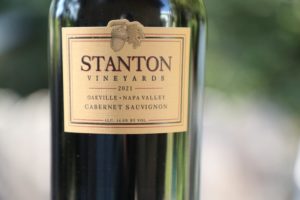
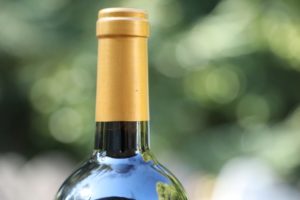
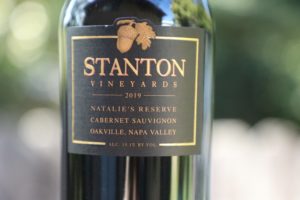
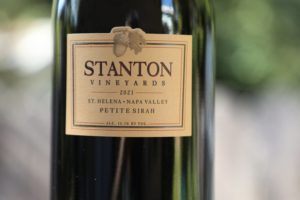

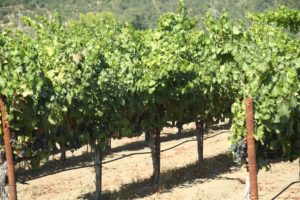
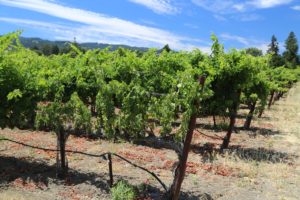
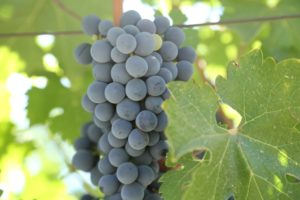
Leave a Reply